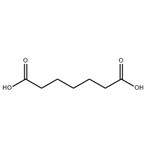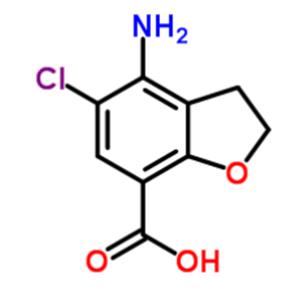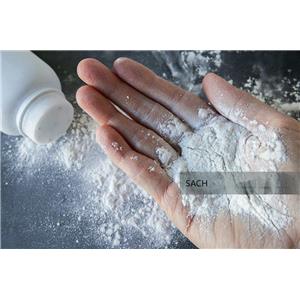
Product Details
| Product Name: Pimelic acid | CAS No.: 111-16-0 |
| EC-No.: 203-840-8 | Min. Order: 1kg |
| Purity: 99% | Supply Ability: 10mt |
| Release date: 2025/06/09 |
Product name: Pimelic acid
CAS Number: 111-16-0
Molecular Weight: 160.17
Molecular Formula:C7H12O4
EINECS Number:203-840-8
RTECS Number:TK3677000
Hazard Note:Irritant
TSCA:Yes
Chemical & Physical Properties
Melting Point | 103-105 °C(lit.) |
Boiling Point | 212 °C10 mm Hg(lit.) |
Density | 1,329 g/cm3 |
Index of Refraction | 1.4352 (estimate) |
Flash Point | 212°C/10mm |
Storage conditions | Store below +30°C. |
solubility | Ethanol: 0.1 g/mL, clear to very blurry |
Acidity coefficient (pKa) | 4.71(at 25℃) |
morphology | powder |
color | White to slightly beige |
| PH value | 3.77(1 mM solution);3.25(10 mM solution);2.74(100 mM solution) |
| Water solubility | 25 g/L (13 ºC) |
| Merck | 14,7431 |
| BRN | 1210024 |
| stability | Steady. Incompatible with oxidants and alkalis. Flammability. |
| InChIKey | WLJVNTCWHIRURA-UHFFFAOYSA-N |
| LogP | 0.610 |
Uses and synthesis of Pimelic acid:
Overview:
Heptanedioic acid & Pimelicacid, also known as peach acid, is a 7-carbon straight-chain saturated diacid. In animals, it is produced by the omega oxidation and β oxidation of fatty acids, and in 1884 Ganttner Fetal produced ricin (hydroxylated animal oleic acid) from castor oil. In 1937, M. Müller isolated it from bovine urine and it was confirmed that it was an essential ingredient for the growth of some strains of diphtheria.
Application: Heptanetic acid is generally used in biochemical research, also in the preparation of polymers, and can also be used as a raw material for plasticizers.
Chemical properties: White monoclinic crystal. Soluble in water, miscible with alcohol and ether, insoluble in cold benzene.
Uses: Generally used in biochemical research, also used in the preparation of polymers, and can also be used as a raw material for plasticizers.
Biochemical research. Organic synthesis.
Production method: Put the sodium metal into isoamyl alcohol at 100 °C, continue to heat it to reflux violently, and add salicylic acid dropwise to dissolve in the solution of isoamyl alcohol. After the reflux reaction is completed, it is cooled to 100 °C, hot water is added under stirring, and the aqueous layer is placed to stand for steam distillation, isoamyl alcohol is removed, and the distillate is collected to a certain amount. The material in the distillation flask is cooled, concentrated hydrochloric acid is added, and then steam distillation is carried out to remove salicylic acid. The residual liquid is then concentrated to precipitate sodium chloride, and cooled to precipitate a mixture of heptanoic acid and sodium chloride. The mixture was extracted with benzene, and heptanetic acid was concentrated and crystallized from the extract. The yield is 43-50%.
Hazard Overview:
Emergency Overview:
Appearance and properties: crystalline
Color: Pale yellow
Causes severe eye irritation. May cause respiratory irritation.
GHS Hazard Categories:
Severe Eye Injury/Ocular Irritation: Category 2A
Heterosexual target organ system toxicity (once
Contact): Category 3 (respiratory irritation)
GHS Label Elements:
Pictogram :
Signal word: warning
Hazard Statement: H319 causes severe eye irritation.
H335 may cause respiratory irritation.
Precautionary Statement: Precautionary Measures:
P261 Avoid inhaling dust/fumes/gases/fumes/vapors/sprays.
P264 Wash your skin thoroughly after work.
The P271 should only be used outdoors or in a well-ventilated area.
P280 Wear eye shields/masks.
Incident Response: P304 P340 P312 In case of inhalation: Move the person to fresh air and maintain a comfortable breathing position. If you feel unwell, call an emergency center/doctor.
P305 P351 P338 In case of contact in eyes: Rinse carefully with water for several minutes. If you wear contact lenses and can easily remove them, remove them. Continue rinsing.
P337 P313 If eye irritation persists: seek medical attention/medical attention.
Storage: P403 P233 Store in a well-ventilated place. Keep containers tightly closed.
P405 Locks must be added.
Disposal: P501 Dispose of contents/containers at an approved waste treatment plant.
Physical and chemical hazards: no classification is required based on the available information.
Health Hazards: Causes severe eye irritation. May cause respiratory irritation.
Environmental hazards: No classification is required based on the available information.
Other harms not covered by GHS: not reported.
Contact Control & Personal Protection:
Hazard composition and occupational exposure limits
Substances that do not contain occupational exposure limits.
Engineering Controls: No data available
Personal Protective Equipment:
Respiratory protection: Required in the event of dust generation. Our recommendations for filtration respiratory protection are based on the following standards: DIN EN 143, DIN
14387 and other incidental standards relating to the respiratory protective equipment used.
Recommended filter type: Filter type P2. Business managers must maintain, clean and test respiratory protective equipment in accordance with the instructions provided by the manufacturer. These measures must be properly documented.
Eye Protection: Protect your eyes with equipment that has been tested and approved by official standards such as NIOSH (USA) or EN 166 (EU). Safety glasses.
Skin and body protection: Wear protective clothing
Hand Protection:
Material : Nitrile rubber
Solvent permeation time : 480 minutes
Glove thickness : 0.11 mm
Protection Index : Full contact
Material : Nitrile rubber
Solvent permeation time : 480 minutes
Glove thickness : 0.11 mm
Protection index : Splash protection
Note: This recommendation only applies to products supplied by us and listed on the Safety Data Sheet for the purpose specified by us. When dissolved or mixed with other substances or in case of deviation from EN 16523-1, please contact a CE approved glove supplier.
Hygiene measures: Change of contaminated clothing. Wash your hands after using this substance.
Company Profile Introduction
You may like
Recommended supplier
| Product name | Price | Suppliers | Update time | |
|---|---|---|---|---|
| $29.00/1g |
VIP6Y
|
TargetMol Chemicals Inc.
|
2025-11-01 | |
| $0.00/25kg |
VIP1Y
|
Shaanxi Dideu New Materials Co. Ltd
|
2025-03-12 | |
| $6.00/1KG |
Hebei Longbang Technology Co., Ltd
|
2025-01-20 | ||
| $150.00/1kg |
VIP1Y
|
Hebei Zhuanglai Chemical Trading Co Ltd
|
2024-11-26 | |
| $1.00/1kg |
VIP7Y
|
Hebei Chuanghai Biotechnology Co., Ltd
|
2024-11-14 | |
| $100.00/5kg |
VIP2Y
|
HEBEI SHENGSUAN CHEMICAL INDUSTRY CO.,LTD
|
2024-08-20 | |
| $1.00/1KG |
VIP5Y
|
Hebei Chuanghai Biotechnology Co,.LTD
|
2024-08-20 | |
| $3.00/1kg |
VIP2Y
|
Henan Fengda Chemical Co., Ltd
|
2024-04-16 | |
| $0.00/1Kg |
airuikechemical co., ltd.
|
2024-04-10 | ||
| $0.00/25KG |
VIP6Y
|
Sichuan Zhuoyu Yantang Technology Co., Ltd.
|
2023-09-08 |
- Since: 2023-06-25
- Address: 2-513, No. 364, Tongyun Street, Liangzhu Street, Yuhang District, Hangzhou, Zhejiang China





acetic Acid](https://img.chemicalbook.com/ProductImageEN1/2025-06/Large/c14f09fe-341c-4f5f-84ce-c48b4022056b.png)

 China
China